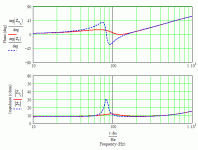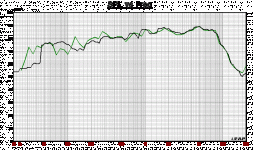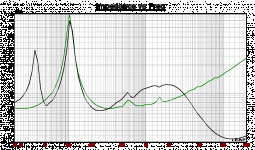otto88 said:a gang plank?
Not of thevariety, methinks, but for what?
Cheers
With a roll-out gantry (and my existing deck) i will be able to position a speaker some 14-16 ft from the nearest reflecting surface (ie ground below, wall behind) which gives a 28-32 ft measuring window. Since this is outside i need to wait till after the monsson season to implement it.
dave
planet10 said:
One can think of aperiodic as in between BR & sealed.........(for the rest of this ramble i'm just goig to use aperiodic to mean the space between BR & sealed).
This and your examples would be ~aperiodic if we accept that aperiodic is without 'period', i.e. no impedance peak(s), then whether acoustic or electrical aperiodic is compared to sealed or vented alignments it sounds like neither to me since it has a ~flat phase response:
GM
Attachments
GM said:
This and your examples would be ~aperiodic if we accept that aperiodic is without 'period', i.e. no impedance peak(s), then whether acoustic or electrical aperiodic is compared to sealed or vented alignments it sounds like neither to me since it has a ~flat phase response:
GM
I should have been somewhat clearer... at somewhere between sealed and BR we get aperiodic (imagine the sealed & BR imp as being averaged, and aperiodic is where the impedance peaks have (mostly) canceled into a flat line). Anything either side of that isn't strictly aperiodic bur near aperiodic or pushed towards aperiodic (as in the case of the Fonken).
This is happening in more than 2-space. I'll typically use the term aperiodic to broadly cover the alignment space around that point.
dave
planet10 said:
... at somewhere between sealed and BR we get aperiodic ...
dave
Hi,
The point of my previous post is that "aperiodic" is not between
sealed and vented.
If anything is on that scale it is below sealed. If you are referring
to resistively damped ports that still "oscillate" to a degree this
is not aperiodic.
Aperiodic implies no port / opening "oscillation", resistive damping
and reduced Qbox and Fbox compared to sealed, complicated by
the possibility of the arrangement adding mass (e.g. damped TL).
As I understand "aperiodic" there are not twin impedance peaks,
only one, and this is lower F and Q compared to the sealed case.
Again I'm not knocking damped vented aligments, nothing wrong
with them if they work as intended, just the terminology used.
🙂/sreten.
Having initially explored enclosures that provide a lower resonance point while minimizing the second peak, technically it seems quite promising, however, I have not yet build a pair for listening.sreten said:
Hi,
The point of my previous post is that "aperiodic" is not between
sealed and vented.
If anything is on that scale it is below sealed. If you are referring
to resistively damped ports that still "oscillate" to a degree this
is not aperiodic.
Aperiodic implies no port / opening "oscillation", resistive damping
and reduced Qbox and Fbox compared to sealed, complicated by
the possibility of the arrangement adding mass (e.g. damped TL).
As I understand "aperiodic" there are not twin impedance peaks,
only one, and this is lower F and Q compared to the sealed case.
Again I'm not knocking damped vented aligments, nothing wrong
with them if they work as intended, just the terminology used.
🙂/sreten.
Idealy if we can lower the resoanance without introduing a new resonance, we should be able to get cleaner bass almost free of distortion caused by interaction between the driver and the port.
As you can see in post#15, the SAFE enclosure also provides similar effects. This version of SAFE did not have a back chamber, and the driver was not sealed tight to the enclosure. I was just curous what the impedance curve would look like. No serious attempt to optimize it. Probably I will spend some more time on it in the future.
Member
Joined 2003
Just FYI...here is impedance for a BMS 18N850 in a 15" U-baffle with and without two layers of 6mm wool felt stretched across the back of the U. (The wiggle at 5k on one trace is just a measurement glitch.)
Paul
Paul
An externally hosted image should be here but it was not working when we last tested it.
An externally hosted image should be here but it was not working when we last tested it.
soongsc
post#15
“an impedance comparison of the JX92S in free air versus in a Symmetric Air Friction Enclosure (SAFE)”
Which is which?
post#15
“an impedance comparison of the JX92S in free air versus in a Symmetric Air Friction Enclosure (SAFE)”
Which is which?
Lower frequency is SAFEotto88 said:soongsc
post#15
“an impedance comparison of the JX92S in free air versus in a Symmetric Air Friction Enclosure (SAFE)?
Which is which?
Great to have measurements. I want to try something similar in a sealed design I'm working on too.Paul W said:Just FYI...here is impedance for a BMS 18N850 in a 15" U-baffle with and without two layers of 6mm wool felt stretched across the back of the U. (The wiggle at 5k on one trace is just a measurement glitch.)
Paul
An externally hosted image should be here but it was not working when we last tested it.
An externally hosted image should be here but it was not working when we last tested it.
GM
---This and your examples would be ~aperiodic if we accept that aperiodic is without 'period', i.e. no impedance peak(s), then whether acoustic or electrical aperiodic is compared to sealed or vented alignments it sounds like neither to me since it has a ~flat phase response---
"Aperiodic" should more or less apply to the Hegeman sub, described here :
audioXpress December 2003
"A Hegeman Subwoofer"
and
http://www.morrisonaudio.com/morrison_loudspeakers.htm
Extracts :
"The back wave of the woofer on the Model 23 and the Model 17 is loaded by a series of stagger tuned tunnels which are closed, not exhausted to the outside of the cabinet. This method results in a flattening of the impedance peak normally found in a sealed box configuration."
"Like its larger brother the back wave of the woofer is loaded by a series of 1/4 wave tunnels of staggered lengths which are terminated. This is not a transmission line (that would imply a tunnel exhausting to the outside of the cabinet). By utilizing 1/4 wave loading the impedance from 35 hZ to 100 hZ varies by no more than +/- 5%. This absense of the normal bass hump in impedance results in very articulate reproduction of low frequencies."
---This and your examples would be ~aperiodic if we accept that aperiodic is without 'period', i.e. no impedance peak(s), then whether acoustic or electrical aperiodic is compared to sealed or vented alignments it sounds like neither to me since it has a ~flat phase response---
"Aperiodic" should more or less apply to the Hegeman sub, described here :
audioXpress December 2003
"A Hegeman Subwoofer"
and
http://www.morrisonaudio.com/morrison_loudspeakers.htm
Extracts :
"The back wave of the woofer on the Model 23 and the Model 17 is loaded by a series of stagger tuned tunnels which are closed, not exhausted to the outside of the cabinet. This method results in a flattening of the impedance peak normally found in a sealed box configuration."
"Like its larger brother the back wave of the woofer is loaded by a series of 1/4 wave tunnels of staggered lengths which are terminated. This is not a transmission line (that would imply a tunnel exhausting to the outside of the cabinet). By utilizing 1/4 wave loading the impedance from 35 hZ to 100 hZ varies by no more than +/- 5%. This absense of the normal bass hump in impedance results in very articulate reproduction of low frequencies."
Paul W said:Just FYI...
Yeah, thanks for that, I periodically tell folks about this and usually get ignored for whatever reason, but the pioneers of audio designed max BW folded mid-bass/bass BLHs for cinema apps and damped its single below passband resonant peak and mids/HF output this way.
GM
forr said:
"Aperiodic" should more or less apply to the Hegeman sub, described here :
Absolutely! A true aperiodic alignment has no output, being a terminated (aka infinite) line, so it doesn't matter if it has a port or not.
GM
Very interesting! Has anyone ever built and measured them? Or does anyone have a pair and measured them?forr said:GM
---This and your examples would be ~aperiodic if we accept that aperiodic is without 'period', i.e. no impedance peak(s), then whether acoustic or electrical aperiodic is compared to sealed or vented alignments it sounds like neither to me since it has a ~flat phase response---
"Aperiodic" should more or less apply to the Hegeman sub, described here :
audioXpress December 2003
"A Hegeman Subwoofer"
and
http://www.morrisonaudio.com/morrison_loudspeakers.htm
Extracts :
"The back wave of the woofer on the Model 23 and the Model 17 is loaded by a series of stagger tuned tunnels which are closed, not exhausted to the outside of the cabinet. This method results in a flattening of the impedance peak normally found in a sealed box configuration."
"Like its larger brother the back wave of the woofer is loaded by a series of 1/4 wave tunnels of staggered lengths which are terminated. This is not a transmission line (that would imply a tunnel exhausting to the outside of the cabinet). By utilizing 1/4 wave loading the impedance from 35 hZ to 100 hZ varies by no more than +/- 5%. This absense of the normal bass hump in impedance results in very articulate reproduction of low frequencies."
B&W's Nautilus's marketing hype indicates each driver is aperiodically loaded, but I've never seen any measurements, so don't know if they really are.
GM
GM
I've seen Richard Small's original doctoral thesis - a big fat book published by the University of New South Wales. It had a full chapter on resistive-vent boxes - unfortunately, the AES in America chose to reprint the chapters on closed and vented boxes, and ignored the one on resistive-vent boxes.
Although I briefly read Small's thesis, it was little more than a glance at the end of a class taught by Bob Ashley in 1976. If my memory serves me right, the resistive-vent box was a true third-order highpass filter, lying between second-order closed boxes and fourth-order vented boxes. The reason this chapter was denied publication was the efficiency-bandwidth factor was just a little bit below a closed box - in other words, in terms of lowest bass in a given-size box, it lost out to a perfectly ordinary closed box, never mind a vented box.
As a third-order highpass filter, the term "aperiodic" is a misnomer - all loudspeakers are highpass filters, with the order and filter shape selected by design (or accident). The best that can be hoped for is a highpass filter with rapid decay characteristics - good step response. Unfortunately, Bessel and Gaussian highpass filters also tend to have the worst distortion characteristics, forcing a choice between good step response and lowest IM distortion (for a given driver).
But - there is a subtle advantage for resistive-vent systems. One of the drawbacks of vented and sealed-box systems is a small zero in the response at very low frequencies (1 Hz or so) that is created by inevitable box leaks. Although very small, these leaks are severe enough that they throw off test-box compliance measurements, and must be accounted for during the Vas measurement process.
This zero in the response, although not present in idealized computer models, are present in real-world speakers, and subtly degrades the step response with a very slow recovery to zero. Well, with a resistive-vent system, the "box leak" is very large - in fact, it is intentional, and part of the design response. Thus, the resistive-vent system can really approach an ideal third-order highpass filter, while closed and vented-box systems have small response abberations that are very far out of the passband - hard to measure, but there in real-world systems.
Although I briefly read Small's thesis, it was little more than a glance at the end of a class taught by Bob Ashley in 1976. If my memory serves me right, the resistive-vent box was a true third-order highpass filter, lying between second-order closed boxes and fourth-order vented boxes. The reason this chapter was denied publication was the efficiency-bandwidth factor was just a little bit below a closed box - in other words, in terms of lowest bass in a given-size box, it lost out to a perfectly ordinary closed box, never mind a vented box.
As a third-order highpass filter, the term "aperiodic" is a misnomer - all loudspeakers are highpass filters, with the order and filter shape selected by design (or accident). The best that can be hoped for is a highpass filter with rapid decay characteristics - good step response. Unfortunately, Bessel and Gaussian highpass filters also tend to have the worst distortion characteristics, forcing a choice between good step response and lowest IM distortion (for a given driver).
But - there is a subtle advantage for resistive-vent systems. One of the drawbacks of vented and sealed-box systems is a small zero in the response at very low frequencies (1 Hz or so) that is created by inevitable box leaks. Although very small, these leaks are severe enough that they throw off test-box compliance measurements, and must be accounted for during the Vas measurement process.
This zero in the response, although not present in idealized computer models, are present in real-world speakers, and subtly degrades the step response with a very slow recovery to zero. Well, with a resistive-vent system, the "box leak" is very large - in fact, it is intentional, and part of the design response. Thus, the resistive-vent system can really approach an ideal third-order highpass filter, while closed and vented-box systems have small response abberations that are very far out of the passband - hard to measure, but there in real-world systems.
salas
Any thoughts as to why the reflex measures less lumpy (but still lumpy) than the resistive?
60-110 Hz bass hole aside, the resistive goes deeper: mustn't be the same as Small's resistive-vents (which had less low bass than a closed box) . .
Do you have a qualitative preference?
Any thoughts as to why the reflex measures less lumpy (but still lumpy) than the resistive?
60-110 Hz bass hole aside, the resistive goes deeper: mustn't be the same as Small's resistive-vents (which had less low bass than a closed box) . .
Do you have a qualitative preference?
The difference in lump & hole areas is due to the interaction of the 2 different bass transfers with room modes. The resistive goes deeper bcs it compliments the particular room gain closer and easier. I prefer resistive for bass information quality and especially for better mids. The SPL loss in the hole area is significant though for a stand alone little system. The shown example blends to a bass module in actual use so the resistive option was a win win choice.
- Home
- Loudspeakers
- Multi-Way
- How should we model aperiodic boxes


